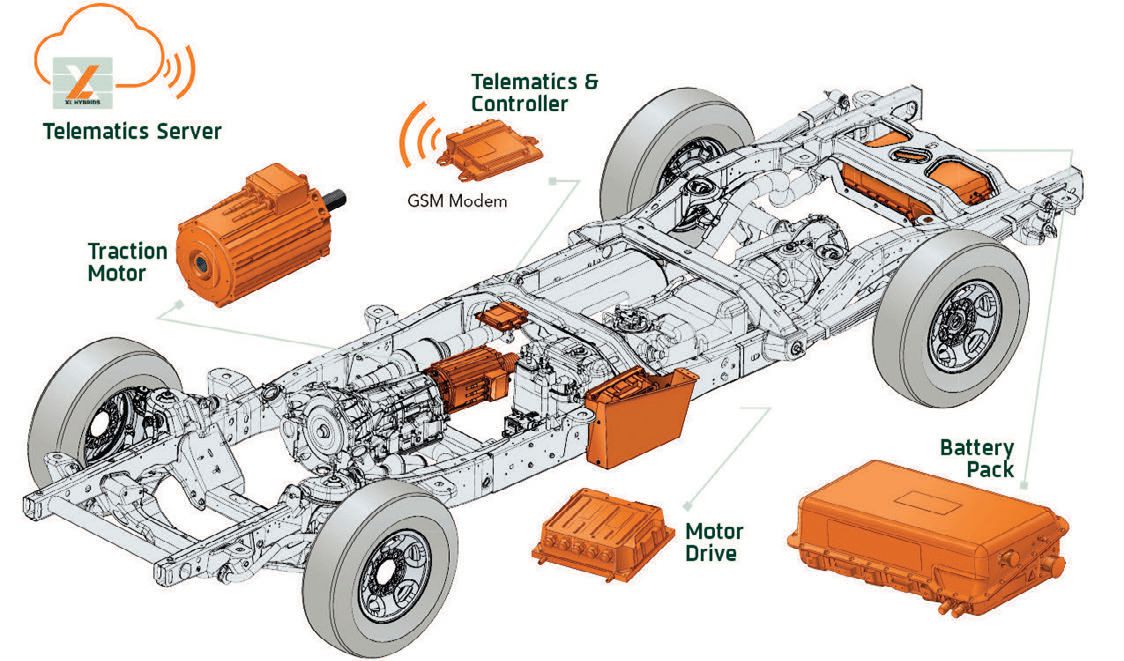Conversion of conventional vehicles to hybrids
Dr. Neil Canter, Contributing Editor | TLT Tech Beat June 2014
Fuel savings can be achieved for a conventional gasoline-powered vehicle through a process known as hybrid conversion.
KEY CONCEPTS
•
Hybrid electric vehicle operation can be added to an ordinary gasoline-powered vehicle through a process known as hybrid conversion.
•
Regenerative braking is used to capture kinetic energy that normally is dissipated as heat.
•
Vehicles using hybrid electric operation have achieved a 20 percent savings in fuel costs along with a corresponding 20 percent reduction in carbon dioxide emissions.
THE DEVELOPMENT OF NEWER TECHNOLOGIES to improve efficiency and productivity can be costly, which acts to hinder their use in commercial applications. One case in point is the ongoing efforts to bring hybrid and electric power capability to automobiles and trucks that use either gasoline or diesel.
A characteristic of hybrid systems that has successfully been used to show their effectiveness at improving fuel economy and reducing emissions is capturing kinetic energy when a vehicle brakes. In a previous TLT article, an energy recovery system used on Class 8 refuse trucks was described (
1). This system replaces the vehicle’s transmission with a three-speed advanced series hydraulic hybrid drive system. It can recover and reuse up to 70 percent of the kinetic energy obtained during braking by using two hydrostatic pumps/motors to transmit the kinetic energy hydraulically into a high-pressure accumulator.
Fuel economy increases between 40 and 80 percent were achieved along with a significant reduction in break wear. This benefit extended brake life up to 12 months.
Dr. Edward Lovelace, chief technology officer for XL Hybrids, Inc., in Boston, says, “We recognize that most fleet owners are looking to reduce fuel usage and reduce emissions in their vehicles. The problem is achieving this goal in a cost-effective manner.”
If a technology could be developed that facilitates the use of hybrid drive systems in a cost-effective manner, then it is likely to be attractive to more vehicle fleet managers. Such as technology has now been developed.
HEV OPERATION
XL Hybrids has developed a very efficient way to take an ordinary gasolinepowered vehicle and provide it with hybrid electric vehicle (HEV) operation through a process known as hybrid conversion. Lovelace says, “We can take a fossil fuel-powered commercial vehicle and install a hybrid electric system in parallel.”
The components needed for HEV operation include a traction motor, motor drive, high voltage lithium-ion battery and a sophisticated controller that interfaces between the electric motor and the conventional gas-powered engine system. An installed telematics unit provides a link to the vehicles to monitor health and performance. These components and their placement in a vehicle are shown in Figure 2.
 Figure 2. A conventional gasoline-powered vehicle can realize the fuel economy and emissions benefits of a hybrid vehicle through the conversion shown. (Courtesy of XL Hybrids, Inc.)
Figure 2. A conventional gasoline-powered vehicle can realize the fuel economy and emissions benefits of a hybrid vehicle through the conversion shown. (Courtesy of XL Hybrids, Inc.)
The major advantage in hybridizing the vehicle is to use regenerative braking to capture the kinetic energy normally dissipated as heat during braking. This energy is converted into electricity and used to charge the battery. The controller then determines the best time to use the battery to release the energy to the electric motor when the vehicle accelerates.
In selecting the right type of vehicle, the objective is to look for fleets that drive primarily in suburban/urban environments where there is a good deal of stop-and-go traffic requiring constant braking. XL Hybrids’ customer experiences have shown that even with a 70:30 ratio of suburban/urban to highway driving, there appears to be sufficient braking and acceleration events to achieve a good savings.
A number of criteria are used in determining what type of vehicle should be fitted with a hybrid system. Lovelace says, “We focused on rear-wheel-drive vehicle fleets and determined the size of the fleets, how many miles are driven in one year, what is the current gas mileage and how much fuel is currently consumed. Based on our assessment, we found that light-to-medium duty gasoline-powered vehicles can gain the greatest benefit from a hybrid conversion. As a result, we targeted owners of fleets that use commercial cargo, delivery and shuttle vans and Class 3&4 service, delivery and shuttle cutaway chassis.”
Significant fuel savings and fuel emissions reductions have been achieved after installing HEV operation in a vehicle. Lovelace says, “We have found that vehicles can realize a 20 percent savings in fuel costs along with a corresponding 20 percent reduction in carbon dioxide emissions.”
As an example showing the performance benefits, five delivery vans were retrofitted with HEV operation and run for a combined 121,500 miles over a one-year operating period. Approximately 69 percent of the miles were driven in a suburban/urban environment. A 20 percent fuel reduction translates into a boost in fuel economy for each van from 11.4 to 14.3 miles per gallon. This fuel savings meant that lifetime carbon dioxide emissions per van declined by 53 tons.
Overall, customer miles driven by vehicles that have undergone the hybrid conversion climbed from 64,420 between April 2012 and February 2013 to over 725,000 miles as of February 2014. Lovelace believes that the hybrid conversion is adaptable to a wide range of vehicles. He adds, “Our approach does not force the customer to have to change the types of vehicles used, servicing required or driver behavior.”
Retrofitting to HEV operation can also lead to additional benefits such as reduced brake wear, less time spent filling up at gas stations and also downsizing engines. The retrofit also does not need to be done at a special time, but can be accomplished easily when commercial fleets are modified.
Additional information can be found in a presentation made at the NTEA Green Truck Summit in March 2014 (
2) or by contacting XL Hybrids at
media@xlhybrids.com.
REFERENCES
1.
Canter, N. (2008), “Hydraulic Hybrid Reaps Fuel Savings,” TLT,
64 (8), pp. 14-15.
2.
Bliss, B. and Lovelace, E., “Deploying Vehicles with Electric Drive Technology: A Primer for Success,” Presented at the Green Truck Summit—The Future of Clean Commercial Vehicles, Indianapolis, IN, March 2014.
 Neil Canter heads his own consulting company, Chemical Solutions, in Willow Grove, Pa. Ideas for Tech Beat items can be sent to him at neilcanter@comcast.net
Neil Canter heads his own consulting company, Chemical Solutions, in Willow Grove, Pa. Ideas for Tech Beat items can be sent to him at neilcanter@comcast.net.